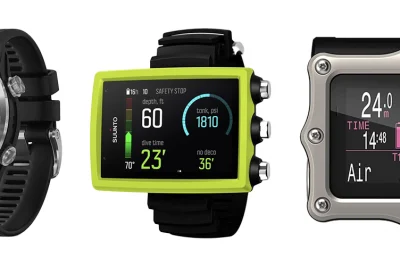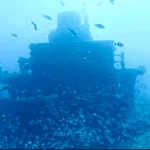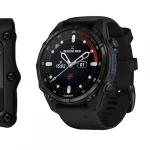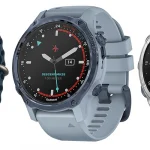Understanding the Digital Dive: A Filmmaker’s Best Friend

Table of Contents
- Understanding the Digital Dive: A Filmmaker’s Best Friend
- Debunking Myths: Why Old-School Methods Won’t Cut It Anymore
- Common Pitfalls in Underwater Filmmaking and How to Avoid Them
- The Future of Underwater Filmmaking Technology
- Choosing the Right Dive Computer: Data-Backed Insights
- Enhancing Efficiency: How Dive Computers Optimize Your Dive
- Safety First: Leveraging Technology for Secure Diving
- The Ultimate Accessories: Pairing Your Dive Computer With Filmmaking Gear
Introduction
Scuba diving and underwater videography are thrilling endeavours that require precision and reliability, especially when capturing the beauty of the ocean. For videographers in Florida, switching to an advanced dive computer system is not just a trend but a necessity. This comprehensive guide will help you understand why this single system is becoming a favourite among underwater filmmakers.
Understanding the Digital Dive: A Filmmaker’s Best Friend
Debunking Myths: Why Old-School Methods Won’t Cut It Anymore
Despite nostalgia for traditional diving techniques such as using dive tables and analog gauges, these outdated methods cannot meet the demands of modern underwater filmmaking, especially in Florida’s dynamic dive environments. Old-school approaches rely on static calculations based on maximum depth without considering the variability of actual dive profiles. This can lead to overly conservative no-decompression limits or, worse, miscalculations that increase risk. For underwater videographers, who often undertake complex, multi-level dives to capture rich cinematic sequences, this limitation restricts both safety and creative freedom.
In contrast, digital dive computers offer a transformative leap in both accuracy and efficiency. These devices continuously monitor every change in depth and time, dynamically adjusting no-decompression limits in real time. This ensures that divers maximise bottom time safely, which is crucial for capturing high-quality footage where every minute counts. Modern dive computers support nitrox mixes, allowing extended bottom times that traditional tables simply can’t accommodate.
Another common misconception is that dive computers are just fancy gadgets without real safety benefits. They come equipped with multiple safety features unavailable in old-school methods, such as customizable ascent rate alarms that warn divers if they’re ascending too quickly—significantly reducing the risk of decompression sickness. They also incorporate advanced decompression algorithms that evolve with current scientific understanding, improving the precision of decompression stops far beyond manual calculations.
For video creators juggling bulky camera gear underwater, the ergonomic design of digital dive computers—often wrist-mounted with bright, easy-to-read displays—dramatically simplifies monitoring vital dive data. Wireless air integration displays remaining tank pressure without cumbersome hoses, helping manage gas consumption seamlessly during complex shoots.
In short, clinging to traditional methods not only compromises safety but limits dive efficiency and control. The sophisticated functionalities of digital dive computers make them indispensable tools for Florida’s underwater filmmakers dedicated to both safety and crafting exceptional visual stories beneath the waves.
Debunking Myths: Why Old-School Methods Won’t Cut It Anymore
Common Underwater Filmmaking Pitfalls and Solutions Using Dive Computers
Underwater filmmaking in Florida’s diverse aquatic environments presents unique challenges that can undermine your footage and safety if not carefully managed. Even the most skilled videographers can fall into common pitfalls; however, a well-utilised dive computer can be a crucial tool to prevent these issues.
1. Exceeding Safe Depth and Time Limits
Mistakes:
- Filming deeper than 10 metres where natural light diminishes rapidly, causing footage to lose vivid colours and become darker and bluer.
- Spending too much time underwater without monitoring no-decompression limits, leading to hazardous decompression sickness (DCS) risks.
Solutions:
- Utilise your dive computer’s depth alarms to set a maximum safe depth, ideally staying within the 5–10 metre range for optimal light and vibrant colours.
- Rely on the dive computer to continuously track your dive time and provide clear no-decompression limits, helping you manage extended shallow dives safely to maximise filming opportunities.
2. Neglecting Critical Dive Vitals
Mistakes:
- Neglecting to monitor your remaining air supply, dive time, and depth while focusing heavily on capturing footage.
- Forgetting to switch on or properly activate the dive computer before the dive, which nullifies accurate tracking of your safety parameters.
Solutions:
- Use dive computers integrated with air pressure transmitters that automatically update your air status, allowing you to focus on filming while still staying informed.
- Adopt a firm pre-dive routine that includes powering on and verifying your dive computer’s settings, ensuring it’s ready to provide real-time vital feedback throughout your dive.
3. Improper Dive Computer Handling
Mistakes:
- Failing to activate the dive computer or neglecting to understand the specific decompression model it uses, which may differ in conservatism levels.
- Overconfidence, assuming prior safe dives without considering that environmental or personal conditions might have changed.
Solutions:
- Make accurate dive computer activation and configuration a mandatory part of your equipment checklist before entering the water.
- Learn your device’s specific algorithm—understand whether it leans conservative or liberal—to align your dive planning, which helps reduce decompression risks while maintaining good bottom times for filming.
4. Distractions Leading to Technical and Safety Oversights
Mistakes:
- Getting absorbed in framing or lighting settings and forgetting to monitor depth or air, leading to unsafe dive profiles.
- Leaving camera lights on unnecessarily, causing backscatter and poor image quality or draining battery power prematurely.
Solutions:
- Leverage your dive computer’s alerts and real-time data as a silent partner—trust that it will warn you about critical limits so you can focus on creative aspects.
- Plan your dive and camera settings pre-descent, minimising adjustments underwater that distract from monitoring safety data accessible via your dive computer.
By avoiding these common errors with thoughtful dive computer use, underwater filmmakers in Florida can protect their safety, enhance their dive efficiency, and capture the stunning marine life and seascapes in their best light. Integrating dive computer vigilance into your filming workflow turns this advanced gear into your most trusted underwater companion.
Common Pitfalls in Underwater Filmmaking and How to Avoid Them
Emerging Trends Shaping Dive Computer Technology
The landscape of dive computers is evolving rapidly, with innovations designed to enhance safety, usability, and environmental responsibility—critical factors for underwater filmmakers in Florida’s unique aquatic environments. One of the most impactful advancements is the integration of artificial intelligence (AI). Modern dive computers employ AI algorithms to analyse dive profiles in real time, adjusting decompression schedules dynamically and offering personalised feedback that helps reduce risks such as nitrogen buildup or decompression sickness. This intelligent adaptation ensures dive plans are optimised continuously during the dive and post-dive logs provide actionable insights tailored to each diver’s physiology and behaviour.
Visual clarity remains paramount underwater. Next-generation dive computers feature OLED color displays, delivering brighter, high-contrast screens visible even in murky or low-light conditions common in Florida’s underwater caves and reefs. Technologies like chip-on-glass further reduce reflections and improve readability, making it easier for filmmakers to monitor critical data without breaking focus during shoots.
Safety customisation has also advanced markedly. Sophisticated decompression models such as the Bühlmann ZH-L16C algorithm allow divers to fine-tune their safety margins based on specific dive profiles, gas mixes, and altitude. Multi-gas support—with some units handling up to five different mixes—enhances flexibility for technical dives or prolonged filming sessions requiring varied breathing gases.
Connectivity features have become essential. Bluetooth-enabled dive computers synchronise effortlessly with smartphones and tablets for streamlined dive logging and planning. Additionally, integration with underwater drones and external imaging devices is becoming standard. This connectivity not only aids data sharing but can also enable remote monitoring and streamlined communication in complex filming setups.
Sustainability is gaining traction in equipment design, with manufacturers adopting eco-friendly materials such as recycled plastics and energy-efficient power systems. These innovations cater to divers and filmmakers mindful of their environmental footprint, particularly in ecologically sensitive areas like Florida’s coral reefs.
Finally, the market is witnessing broadening accessibility. Entry-level models now offer many features once exclusive to premium units, including Bluetooth connectivity and improved algorithms. This democratisation allows underwater videographers—from hobbyists to professionals—to benefit from cutting-edge technology that enhances both safety and the quality of their work.
Key Features to Consider for Future-Proof Dive Computers
- AI-Driven Dive Planning: Enables personalised, dynamic adjustments to dive safety profiles.
- High-Visibility OLED Displays: Improves readability in diverse underwater conditions typical of Florida dive sites.
- Multi-Gas Compatibility: Supports complex diving scenarios for technical or extended filming dives.
- Bluetooth and Device Integration: Facilitates seamless data management and interaction with video capture tools.
- Sustainable Materials and Power Efficiency: Aligns gear with environmental responsibility in fragile marine ecosystems.
- Enhanced Entry-Level Options: Makes advanced technology accessible to a wider range of divers and creators.
Understanding these evolving trends empowers underwater filmmakers in Florida to select dive computers that not only meet today’s demands but also adapt to future innovations—ensuring safety and excellence in capturing the underwater world.
My Favorite Dive Computers
I have compared the 3 top diving computers for each category to help making the right choice easier:
The Future of Underwater Filmmaking Technology
Choosing the Right Dive Computer: Data-Backed Insights
When selecting a dive computer tailored for Florida’s underwater filmmakers, understanding the balance between performance, usability, and specific features is critical. Dive computers vary greatly by diving style—technical, recreational, smartwatch integrated, and budget-friendly models—each offering distinct advantages that can impact your underwater filming experience.
Technical and Recreational Diving Models
The Shearwater Perdix 2 stands out as a top choice for technical divers needing precise decompression algorithms and excellent display visibility in challenging conditions. It features the renowned Bühlmann ZH-L algorithm with gradient factors, a customizable AMOLED display, and a depth rating reaching 120 metres, ideal for deep cave dives Florida is famous for. Users praise its reliability in low-light environments and accuracy, making it a trusted tool for precise dive planning and safety.
Another technical option is the Garmin Descent Mk2i, which integrates dual algorithms (Bühlmann and ZHL-16) and offers GPS precision and smartwatch-like features. Its large, crisp LCD display and Bluetooth connectivity allow divers to track detailed dive metrics and sync data conveniently.
Watch-Style Dive Computers for Style and Functionality
For divers seeking sleek design and customisation, the Suunto D5 merges fashion with function. It supports multiple gas mixes, including Nitrox, integrates air data, and features a digital compass paired with a user-friendly app for dive logging and customisation. The Suunto Ocean elevates this with smartwatch integration, a responsive touchscreen, and intuitive alerts, catering to divers who want advanced tech alongside effortless operation.
The Aqua Lung i450T offers a more budget-conscious alternative yet delivers wireless transmitter compatibility and a clear matrix display, praised by many as “the only computer needed” for recreational diving.
Smartwatch Integrated Dive Computers
The Garmin Descent series also leads in smartwatch integration, combining fitness tracking with comprehensive dive metrics. This is invaluable for underwater filmmakers who want a multifunctional device for both diving and everyday use. Apple Watch Ultra, though requiring third-party apps, can serve as a dive computer, though it’s less specialised and suited for casual use rather than technical dives.
Budget-Focused Models with Good Reliability
For those starting out or needing a straightforward, reliable computer, models like the Mares Puck 4 and Aqua Lung i470TC provide essential air and Nitrox monitoring at an accessible price. These units emphasise simplicity and dependability and are ideal for Florida’s popular shallow to medium-depth reefs and wrecks.
User Experience at a Glance
- Shearwater Perdix 2: “Precise decompression and excellent display in low light” praised by technical divers.
- Suunto D5: Valued for customizable interfaces and stylish design, enhancing user engagement.
- Garmin Descent Mk2i: High scores for dual algorithms and GPS-enabled dive tracking.
- Mares Puck 4: Trusted for simple reliability, ideal for beginners on a budget.
Ultimately, Florida’s underwater videographers need a dive computer that aligns with their diving style, technical requirements, and how much integration they desire with other devices or apps. In-depth user feedback consistently highlights the importance of ease of use combined with accurate dive data for safe, confident filming underwater.
Summary Table
| Category | Best For | Top Model(s) |
|---|---|---|
| Technical Diving | Precision in decompression and display | Shearwater Perdix 2 |
| Watch-Style | Customisation and aesthetics | Suunto D5, Suunto Ocean |
| Smartwatch Integration | Fitness and dive metric tracking | Garmin Descent Mk2i |
| Budget | Entry-level reliability | Mares Puck 4, Aqua Lung i470TC |
Choosing the Right Dive Computer: Data-Backed Insights
Optimising Dive Efficiency
Dive computers have revolutionised underwater exploration by providing real-time, dynamic monitoring that traditional dive tables cannot match. They continuously measure critical parameters such as depth, dive time, and nitrogen absorption, allowing for instant adjustments in no-decompression limits (NDLs) and ascent rates. This adaptive tracking maximises your allowable bottom time while maintaining safety throughout multi-level dives, particularly important in Florida’s diverse dive sites where depth profiles can change quickly.
- Real-Time Data Monitoring: Constant updates on nitrogen loading and decompression status help avoid exceeding safe limits, enabling longer and safer dives without unnecessary conservative margins.
- Air Integration and Gas Management: Many modern dive computers connect wirelessly to tank pressure transmitters, calculating your exact gas time remaining (GTR). This integration removes the need for separate submersible pressure gauges (SPGs), streamlining your equipment and focusing your attention on the dive and filming.
- Dynamic Algorithm Adaptation: Sophisticated dive algorithms adjust decompression schedules and ascent profiles on the fly, considering changing depths and gas consumption rates. This flexibility allows divers to optimise their profiles for safety and efficiency, which is crucial when capturing footage that requires prolonged bottom times or complex dive patterns.
- Safety Enhancements: With alerts for rapid ascents, missed safety stops, or low air warnings, dive computers proactively help reduce risks while maximising the available time underwater, critical for capturing those fleeting aquatic moments.
Enhancing Underwater Footage Quality
Beyond safety and efficiency, dive computers increasingly serve as vital tools for underwater filmmakers by synchronising environmental data with camera systems to dramatically improve footage quality.
- Depth Data Synchronisation: Linking dive computer depth data with camera timestamps allows for precise depth metadata embedding. This enables advanced post-processing techniques like depth mapping, which can improve focus accuracy and visual storytelling by showing depth context or highlighting subject environment.
- Autofocus and Exposure Optimisation: Cameras that utilise synchronised dive data can adjust autofocus and exposure settings based on depth-related light conditions. Cutting-edge cameras with global shutter technology reduce motion blur when filming fast-moving subjects like fish or sharks, enhancing image sharpness during action shots.
- Post-Processing with Depth Metadata: The availability of depth information empowers editors to apply effects like selective blurring or backscatter reduction, producing cleaner images. It also aids in ecological research by documenting the exact depth and habitat of marine species captured on film.
- Environmental and Ecological Monitoring: Integrating dive computer logs with visual data helps underwater filmmakers contribute to scientific monitoring, tracking species behaviour and habitat conditions over time—a valuable added benefit for conservation-minded creators working in Florida’s delicate reef systems.
- Synchronised Lighting Control: Dive computers can communicate with underwater strobes to optimise flash timing and intensity relative to depth and camera settings, reducing backscatter and balancing lighting even in typically low-light or murky environments.
Together, these capabilities elevate dive computers from mere safety gadgets into indispensable, multifunctional tools that optimise your dive efficiency while pushing the creative boundaries of underwater filmmaking.
Enhancing Efficiency: How Dive Computers Optimize Your Dive
Critical Safety Features of Dive Computers for Underwater Filmmakers
Underwater filmmakers face unique challenges that demand reliable dive computer features prioritising safety without hindering creative flexibility. Several advanced safety functionalities stand out as essential to balance artistic pursuits with health protection during extended and complex dives.
Decompression Algorithms
Modern dive computers utilise real-time decompression algorithms that continuously track your depth and bottom time to calculate safe ascent profiles. These calculations minimise the risk of decompression sickness by dynamically adjusting the no-decompression limits as your dive progresses. Underwater filmmakers who often undertake prolonged bottom times to capture precise shots benefit considerably from this feature, as it tailors safe limits to the specific demands of each dive.
Ascent Rate Monitoring
One of the most critical safety features is strict ascent rate monitoring, typically limiting ascent speeds to around 30 feet per minute. Dive computers provide audible and visual alerts if you ascend too rapidly, protecting you from rapid pressure changes. This system is invaluable in underwater filmmaking scenarios where focus on shot composition might distract from monitoring ascent speed.
Customisable Safety Stops
- Standard Safety Stops: Most computers enforce mandatory stops, commonly a 3-minute pause at 15-20 feet, designed to allow excess nitrogen to safely off-gas.
- Extended Safety Stops: For dives with increased physical exertion or longer bottom times, stops can be extended to 5 minutes for added safety.
- Optional Deep Stops: Some computers offer selectable stops at deeper levels (30-50 feet), which can reduce microbubble formation, especially useful during multiple or repetitive dives.
These customisable stops accommodate the physical intensity often experienced during filming, where motion and breath control might increase decompression stress.
Depth and Time Tracking with Alerts
- No-Decompression Limit Tracking: Real-time display of remaining safe time at current depth helps filmmakers plan their shots without exceeding safety margins.
- Maximum Depth Alarms: Alerts notify if you exceed preset depth limits, vital during low-visibility or fast-paced filming where accidental descents can occur.
Additional Safety Features
- Conservative Factor Adjustment: Allows divers to increase safety margins by reducing allowable bottom time, a prudent option during strenuous dives typical of underwater filming.
- Tank Pressure Integration: Some dive computers sync with tank pressure sensors to alert of low air supply, preventing surprises when your attention is on capturing the perfect shot instead of checking gauges.
By leveraging these safety features, underwater filmmakers in Florida and elsewhere can confidently explore creative depths, secure in the knowledge that their dive computer is continuously managing vital safety parameters tailored to the demands of their dives.
Safety First: Leveraging Technology for Secure Diving
Integrating Your Dive Computer with Underwater Filmmaking Gear for Seamless Results
For underwater filmmakers in Florida aiming to capture exceptional footage, pairing your dive computer with filming equipment wisely can elevate both your workflow and final product. Modern dive computers often come equipped with Bluetooth or Wi-Fi connectivity, enabling real-time syncing of critical dive data—such as depth, time, and location—with your camera’s metadata. This integration simplifies organising and editing footage by automatically timestamping dive logs alongside video clips.
Leading models like the Shearwater Perdix 2 and the Garmin Descent Mk3i stand out in this realm. The Shearwater system connects via Shearwater Cloud and is compatible with third-party apps like Dive++ and Logbook Divers to match dive data with your photo or video timeline. The Garmin Descent Mk3i adds advanced GPS geotagging at high accuracy, invaluable for location-based documentation of Florida’s diverse underwater environments. These capabilities create an efficient, mostly automated workflow for filmmakers who prefer to focus on shooting rather than manual data management.
For filmmakers seeking more control or working with equipment that lacks wireless features, post-production solutions provide another effective option. Software such as DashWare allows you to overlay depth, time, and other telemetry onto your footage after diving. This requires capturing reference shots of your dive computer screen underwater, then manually syncing that data with your video timeline in editing. Although more time-consuming, this approach is highly customisable and works regardless of your computer’s connectivity.
Another practical technique is physically mounting your dive computer onto your camera housing using systems like ULCS arms or float arms. This lets your dive computer’s screen appear directly in the frame during filming, which is handy for real-time data visibility and capturing authentic dive conditions. While it doesn’t automate data syncing, it offers a straightforward, gear-friendly method to integrate your dive data visually.
While air integration transmitters mainly focus on gas monitoring, their wireless technology underscores the potential for future innovations in real-time data sharing between dive computers and filming gear. For now, prioritising dive computers with wireless syncing or using post-production overlays offers the best balance of convenience and precision for underwater filmmakers.
Practical Tips for Florida Underwater Filmmakers
- Choose dive computers with Bluetooth or Wi-Fi: It streamlines syncing and reduces post-dive hassles.
- Use apps like Dive++ or Logbook Divers: These facilitate matching your footage with depth and location data.
- Consider GPS-enabled models: They help document Florida’s iconic dive spots with precise location tagging, enhancing storytelling.
- If wireless isn’t an option, plan to capture reference shots: Ensure your dive computer display is visible periodically during dives for easier post-edit syncing.
- Opt for reliable mounting hardware: Tools like ULCS arms keep your computer safely attached and visible without obstructing filming.
By thoughtfully integrating your dive computer with your filming setup using these methods, Florida underwater filmmakers can maximise efficiency, accuracy, and storytelling impact on their dives.
The Ultimate Accessories: Pairing Your Dive Computer With Filmmaking Gear
Essential Features of Dive Computers Tailored for Underwater Filmmakers
Underwater filmmakers in Florida demand dive computers that do more than just track depth and time—they require multifunctional devices that seamlessly integrate with their filming workflow and diving conditions. Key features enhancing their diving and creative experience include:
- High-Visibility, Customisable Displays: Bright, large screens such as AMOLED or matrix displays provide quick, clear access to critical dive data like depth, dive time, and remaining air. Customisable interfaces allow filmmakers to prioritise the information they need most without distraction, which is crucial when juggling both diving and camera operations in diverse lighting conditions underwater.
- Air Integration with Real-Time Monitoring: Air-integrated dive computers utilise wireless transmitters to display tank pressure and air consumption rates directly on the screen, eliminating manual checks that could divert attention from filming. This feature helps filmmakers plan longer bottom times needed for capturing extended underwater scenes, while alerts like turnaround alarms facilitate efficient dive management.
- Data Logging and Connectivity: Integrated Bluetooth or USB connectivity enables automatic logging of dive profiles that can sync with camera metadata. This powerful feature streamlines post-dive editing and ensures that footage and dive data align perfectly, which is invaluable for producing coherent and safety-accurate underwater films.
- Compact, Ergonomic Design: Filmmakers often prefer wrist-mounted or console-mounted dive computers with minimal bulk. Compact size ensures the computer does not interfere with the handling of camera housings and rigging, facilitating greater freedom of movement during complex underwater shots.
- Enhanced Safety Alerts: Beyond basic safety stops, dive computers designed for filming often include alarms for depth limits and ascent rates tailored to avoid decompression sickness, keeping filmmakers safe despite the distractions of filming. Automatic safety stop reminders enforce conservative dive practices, even during lengthy or intense shoots.
- Technical Diving Capabilities: Some dive computers include support for trimix and other gas mixes, expanding the safety envelope for deeper or longer technical dives to capture rare or difficult underwater footage.
Practical Application: Experienced underwater videographers sometimes use older models repurposed as secondary displays mounted near camera rigs to monitor depth and time independently of their wrist unit. This ensures consistent environmental awareness without crowding their primary device.
Top models favoured by Florida underwater filmmakers include the Shearwater Teric with its colour AMOLED display and Bluetooth syncing, the Suunto EON Core with a large, clear matrix display, and the Aqua Lung i450T, appreciated for its durable watch-style design and reliable air integration. These computers balance advanced dive features with usability in underwater filming environments.
Sources
- Coral Grand Divers – Should I Own a Dive Computer?
- Scubapro – Dive Computer Essentials: Choosing the Right One
- Scubapro – Dive Watch vs Dive Computer
- OceanVibration – Top 10 Beginner Mistakes When Filming Underwater
- DANSA – Your Dive Computer Tips and Tricks
- Dive In Australia – 5 Mistakes to Avoid When Filming Underwater
- Florida Scuba Diving – 2025 Dive Computer Comparison
- Paragon Dive Store – Top Scuba Gear Trends for 2025





